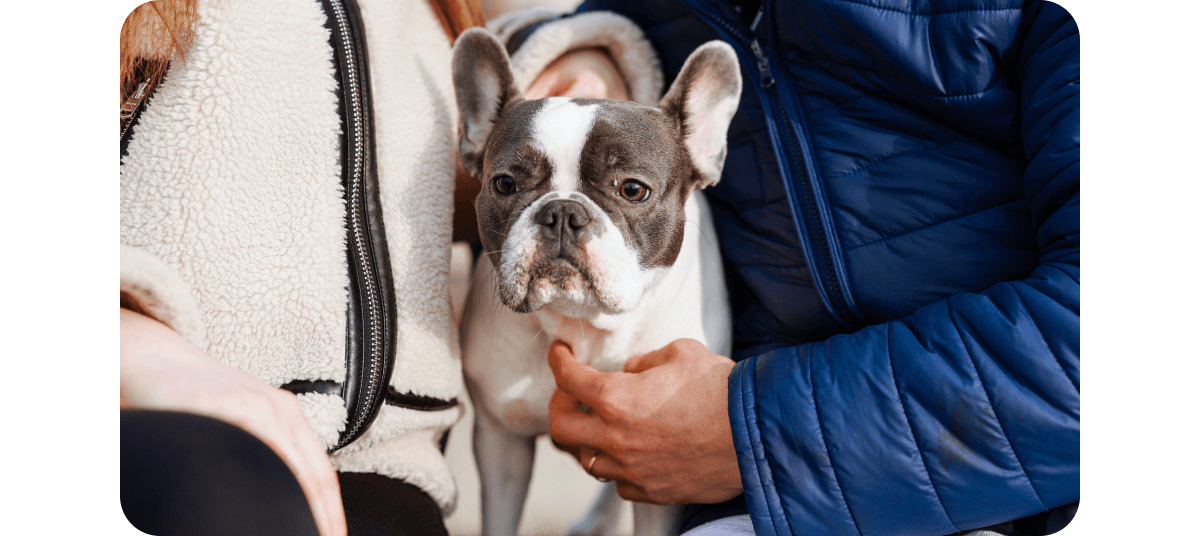Everything you need to know about German Shepherds
Written by Napo HQ
Reviewed by Dr. Oli Robinson MRCVS and The Finchley Vet team
7th Jul 2023
8 mins read

Summary
Smart, strong, and super loyal. The German Shepherd is well known for its work in the army and the police, but they also make amazing pets for active people!
Key Stats
Height
55 to 65cm
Weight
22 to 40kg
Size
Large
Lifespan
9 to 12 years
Coat
Medium or long, straight
Exercise
1 to 2 hours daily
Grooming
Weekly
Temper
Strong willed, brave, smart
Breed history
The German Shepherd has a surprisingly short breed history, having emerged in 1899. The breed owes its existence to a guy called Max von Stephanitz. Von Stephanitz was a German cavalry officer but had been a student of the Berlin Veterinary College and a member of a short-lived society that tried to standardise dog breeds in Germany. He was also convinced dogs should be bred for their working ability.
He fell in love with a shepherd dog named Hektor at a dog show in 1899. Hektor had all the traits von Stephanitz was looking for. Strength, smarts, and an eagerness to work. It helped the dog was pretty good looking too!
He bought the pooch and renamed him Horand von Grafrath. He then founded the “Society for German Shepherd Dogs” and declared Horand as the first-ever German Shepherd. And thus, the breed was born.
Like a lot of working dogs, the breed eventually split into two types, a working line and a show line which have a few physical and personality differences.
Today, German Shepherds are one of the most popular dog breeds in the world. They’re not just working dogs though, they’ve been film stars, and now a popular family pet.

Appearance
German Shepherds are large dogs with a “wolf-like” appearance, thanks to their upright ears and stance. They can have medium or long fur, which is always straight and shouldn’t be overly fluffy. The fur on their neck is often slightly longer, giving them a subtle “mane”, and their tail is often slightly plumed. Sometimes, a German Shepherd’s back can slope downwards towards the tail, but this shouldn’t be extreme. They’re always some combination of black, tan, grey or sable.
German Shepherd colours
German Shepherds come in a relatively small number of colours. They will always be either black, grey, tan, or sable, or some combination of those colours. There can be cream German Shepherds, which are a light gold colour, but the colour is not considered a breed standard. Most German Shepherds are a shade of brown, like tan, with black markings. These markings are often a dark mask on the face, and either a “saddle” or “blanket” shape on their back.
The German Shepherd colours according to the Kennel Club breed standard are:
-
Black
-
Black and gold
-
Black and tan
-
Dark sable
-
Gold sable
-
Grey
-
Grey sable
-
Sable
Temperament
A German Shepherds temperament is energetic, brave, intelligent, and loyal. These pups are known for their versatility, since they’re just as happy as an active family pet as they are working hardcore jobs.
The German Shepherd’s smarts are off the charts! They’re the 3rd smartest dog breed in the world, right behind Poodles and Border Collies. Their quick brains are what make them such incredible working dogs, and this means they can pick up cues and training pretty quickly.
As they are a herding breed originally, these dogs are protective and loyal. These transferable skills that meant they’re right at home as guard dogs, search and rescue dogs, and police or military dogs. It means they bond closely with their humans, but are aloof around strangers and stranger dogs. It also gives them a tendancy to be hyper-aware of their surroundings, which can lead to nervousness. Training and socialisation is essential then, and they tend to be better suited for experienced owners.
That means that it's important to remember that German Shepherds thrive on activity and tasks. A bored German Shepherd can be mischievous, and will find things to occupy them if you don’t give them enough to do! So lots of mental and physical activity are a must, but you’ll earn a very loyal furry friend for it.

How much exercise does a German Shepherd need?
Being an active working dog, a German Shepherd needs a lot of exercise every day. It’s advised they have at least 2 hours of exercise per day. But remember, that doesn’t just have to be walks, other exercises like swimming or doggy sports count too. Plus, training and mental stimulation can also supplement some physical activity. So it can be a good idea to aim for exercise that’s both physically and mentally stimulating.
How to groom a German Shepherd
Since German Shepherds have a thick double coat, they are pretty weather-resistant, and dirt resistant! You won’t need to clip their fur, just give it a weekly brush to help get rid of any dead fur or dirt. You should also bathe your pup every 3 months at least, to help keep their skin and fur clean and healthy. Otherwise, you should clean their teeth regularly to help prevent dental disease, and clip their claws once a month.

Common German Shepherd health problems
Joint problems
One of the most common German Shepherd health problems is hip dysplasia or elbow dysplasia. It’s a common problem large breeds, including German Shepherds. Sadly, this breed is one of the most likely to develop joint problems, and the risk increases with age. This is where the joints don’t develop properly, and can lead to arthritis. If you want to get a German Shepherd, make sure the breeder has screened the parent dogs for elbow and hip scores.
Spinal problems
German Shepherds can develop a condition called Canine Degenerative Myelopathy (DM) or Chronic Degenerative Radiculomyopathy (CDRM). It causes weakness or paralysis in the back legs. Again, breeders should screen their dogs before breeding.
Eye problems
Eye problems are another common German Shepherd health problem. They can be prone to cataracts, which can cause vision loss. They can also develop multifocal retinal dysplasia, which is where the layers of the retina in their eye don’t develop properly.
Anal furunculosis
This is a painful condition that causes inflammation and ulcers around the dog’s anus. German Shepherds are the breed most prone to the condition, particularly in middle age or older.
Epilepsy
German Shepherds can be prone to epilepsy, which causes seizures.
Bleeding disorders
German Shepherds can be prone to different types of haemophilia. These conditions mean that if an affected dog is injured, the wounds don’t scab or clot properly and they bleed more than normal. Dogs can be screened for these condition.
Pituitary dwarfism
It is rare, but German Shepherds are more prone to this hormonal deficiency than other breeds. It impacts their growth and sadly reduces their lifespan.
Frequently asked questions about German Shepherds
How long do German Shepherds live?
German Shepherds live about 10 to 13 years. The average lifespan for dogs is about 12 years, but big breeds, like German Shepherds, sadly tend to live shorter lives.
Are German Shepherds easy to train?
German Shepherds can be easy to train, because they are very intelligent and eager to work. They thrive on having tasks to perform! Training is a great way to provide your dog with mental and physical enrichment, so you should incorporate regular training sessions into your days.
When do German Shepherds stop growing?
German Shepherds are fully grown when they’re about 18 to 24 months old. This is because they’re a large breed of dog, and bigger dogs tend to take longer to grow than smaller breeds. Plus, female dogs are usually smaller and lighter than male dogs, so they tend to reach their adult size earlier.
Want to know more about when puppies are fully grown? Check out this guide.
Are German Shepherds good with kids?
German Shepherds can be great family dogs as long as they have plenty of high quality training and socialisation. They’re loyal and protective pups, so they bond closely with their families, including the kids. But because they are big, strong dogs, care should be taken around young children.
Do German Shepherds shed?
Yes, German Shepherds shed. They’re a double coated breed, so will shed quite a lot, all year round. However, they will noticeably shed more in the spring and autumn months as they changed from their winter coat to their summer coat, and vice versa.
Are German Shepherds hypoallergenic?
No, German Shepherds are not considered hypoallergenic. They shed quite a lot, which includes shedding their hair and dander. (Dead skin.) Allergies are commonly caused by dander, but can be triggered by fur or saliva too. Remember, no dog is 100% hypoallergenic, and sensitivities can vary with different breeds.
How fast can a German Shepherd run?
There's no definite scientific answer, but a German Shepherd can run up to 48 km/h, or about 30 mp/h. That's more than double the speed of a decent human runner! That's pretty fast, but nowhere close to the fastest dog on the planet, the Greyhound, who can top out at a ridiculous 72 km/h!
Working vs show German Shepherd
The main difference between a working German Shepherd and a show one is looks.The working line is more athletic, with a straighter back and a more wolf-like look appearance.
Meanwhile, the show line is larger and stockier, often with an angulated rear end that slopes downwards. However, there’s some controversy around their sloped backs, as breeding for this appearance has caused some health problems in German Shepherds.
As well as their looks, there can be slight personality differences between the two types of dog. Working dogs tend to be more energetic, whereas show line dogs are sometimes more laid back.
Alsatian vs German Shepherd
There’s actually no difference between a German Shepherd and an Alsatian. They’re the exact same breed, it just has two names!
Why are German Shepherds called Alsatians?
German Shepherds were renamed “Alsatian Wolf Dogs”, or Alsatians, after the First World War. This is because there was some anti-German sentiment throughout the UK and Europe. It was thought the “German” name would make the dog unpopular, so it was instead renamed by the UK Kennel Club as an “Alsatian” after the Alsace region of France which borders Germany. However, the breed was originally called a German Shepherd Dog, and this is what they’re mostly called today.
Jump to
Why isn’t my cat using the litter tray?

Why isn’t my cat using the litter tray?
By Rachel Rodgers MSc, Head of Training at Napo Pet Insurance
Blog
10 things you need to know about Frenchies

10 things you need to know about Frenchies
By Rachel Rodgers MSc, Head of Training at Napo Pet Insurance
Blog
Are Frenchies aggressive or stubborn?

Are Frenchies aggressive or stubborn?
By Rachel Rodgers MSc, Head of Training at Napo Pet Insurance
Blog